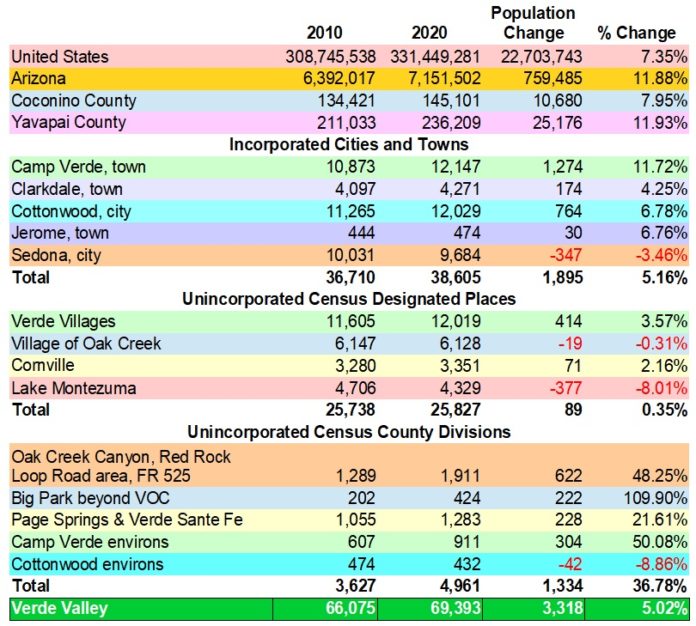The 2020 U.S. Census Bureau results are in, and they show that the Verde Valley as a whole is growing, with just a few municipalities shrinking in population.
Population
As a whole, the Verde Valley has seen an increase of just over 3,000 residents from 2010. The entirety of Yavapai County has increased from 211,033 in 2010 to 236,209 in 2020. The city of Cottonwood has gone from 11,265 in 2010 to 12,029 in 2020, Camp Verde has increased from 10,873 to 12,147, while Sedona has actually decreased in size, going from 10,031 in 2010 to 9,684 in 2020.
Beyond that, Clarkdale has increased from 4,097 to 4,271, Cornville has grown from 3,280 to 3,351, the Verde Villages has gone from 11,605 to 12,019, Jerome has risen from a population of 444 to 474, and the Yavapai-Apache Nation has increased significantly from 557 to 1,207. The Village of Oak Creek has seen a decline from 6,147 to 6,128.
These numbers align with the direction the population was moving during the 2000 census, in which all of the municipalities in the region reported growth except for Sedona, which saw a population decline of 161.
Demographics
Most people in the Verde Valley are adults. Only around 14% of the population of the Verde Valley are children. The median age is approximately 50.1, which is noticeably higher than Arizona’s median age of 38.3. Sedona and VOC have the highest median ages at 61.2 and 62.8, respectively. The youngest population is the Yavapai-Apache Nation with an average age of 27.2.
Around 51% of the population of the Verde Valley is female and about 49% is male. Camp Verde has the largest difference between sexes with 47.2% of the population being female and 52.8% being male. The Verde Villages has the most even split with 50.1% females and 49.9% males.
The vast majority of the Verde Valley is white, making up 68.4% of the population. This is a bit higher than the 54% white population of Arizona as a whole.
Education and Income
Around 23.4% of the population of the Verde Valley has a bachelor’s degree or higher compared to the 30.2% in Arizona as a whole. Sedona is the most educated community with 49.6% of the population having a bachelor’s degree or higher, while the Yavapai Apache Nation has the lowest percentage of degree-holding residents with 5.1% of the population having at least a bachelor’s degree.
The median household income in the Verde Valley is $52,083. The community with the highest income is Cornville, with a median household income of $67,848. Sedona is not far behind with a median household income of $61,470. The Yavapai-Apache Nation has the lowest median household income at $21,042, and Camp Verde has the second-lowest at $39,681. Cornville is the only community in the region that has a median household income above the Arizona median of $62,055.
Around 17.3% of people in the valley are considered to have an income below the poverty level, which is higher than the state percentage of 13.5%.
Other Statistics
The Verde Valley has a higher-than-average number of veterans. Around 12.5% of the population has a veteran status as opposed to the 8.5% statewide. Jerome has the largest population of veterans with 17.4% of its 474 residents holding that status.
A total of 12.4% of Verde Valley residents do not have health insurance compared to the state’s 11.3%.
Just over 72% of Verde Valley residents are homeowners, a significantly higher rate than the Arizona percentage of 65.3%. Cornville has the highest population of homeowners with 89.3% of residents owning their house. Sedona also has a high rate of 76.9% homeowners while the community with the lowest percentage of homeowners is Cottonwood, with only 48.9%.
The housing vacancy rate in the Verde Valley is just over 14% compared to Arizona as a whole’s vacancy rate of 13.2%. The community with the lowest vacancy rate is Clarkdale with 4.1%, while the locality with the highest vacancy rate is the Village of Oak Creek at 26.5%.
Nonrepsonse Bias
The number of households that did not respond to the 2020 census has been increasing for a while and was significantly worse than usual in 2020 thanks to the COVID-19 pandemic. Because of this, the Census Bureau makes certain adjustments to help negate the “nonresponse bias” that occurs when people choose not to respond.
In addition to certain statistical equations used to adjust for more accurate numbers, the bureau uses information from tax forms to verify those who did respond and identify those who didn’t. This also helps ensure that their income, demographic and socio-economic statistics are as accurate as possible.
The Camp Verde Journal, Cottonwood Journal Extra and the Sedona Red Rock News will continue to analyze the data released about the Verde Valley in the coming weeks.




